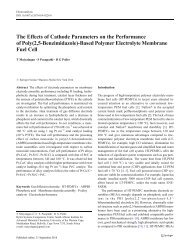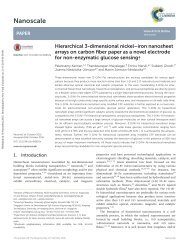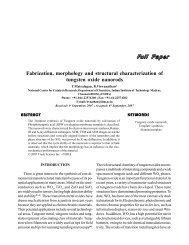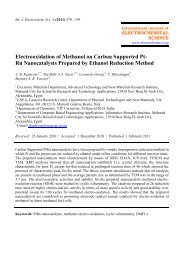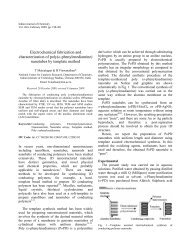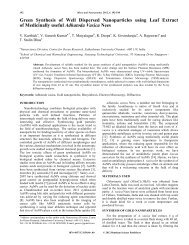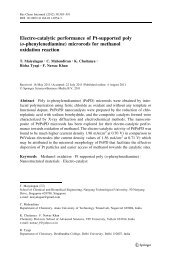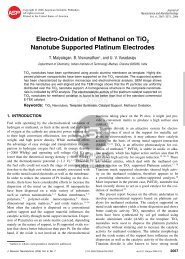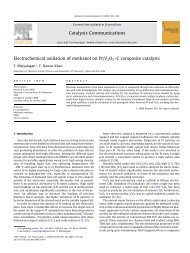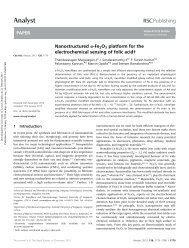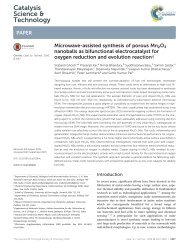Role of the Morphology and Surface Planes on the Catalytic Activity of Spinel LiMn1.5Ni0.5O4 for Oxygen Evolution Reaction
Create successful ePaper yourself
Turn your PDF publications into a flip-book with our unique Google optimized e-Paper software.
See discussi<strong>on</strong>s, stats, <str<strong>on</strong>g>and</str<strong>on</strong>g> author pr<str<strong>on</strong>g>of</str<strong>on</strong>g>iles <strong>for</strong> this publicati<strong>on</strong> at: https://www.researchgate.net/publicati<strong>on</strong>/263976567<br />
<str<strong>on</strong>g>Role</str<strong>on</strong>g> <str<strong>on</strong>g>of</str<strong>on</strong>g> <str<strong>on</strong>g>the</str<strong>on</strong>g> <str<strong>on</strong>g>Morphology</str<strong>on</strong>g> <str<strong>on</strong>g>and</str<strong>on</strong>g> <str<strong>on</strong>g>Surface</str<strong>on</strong>g> <str<strong>on</strong>g>Planes</str<strong>on</strong>g> <strong>on</strong> <str<strong>on</strong>g>the</str<strong>on</strong>g><br />
<strong>Catalytic</strong> <strong>Activity</strong> <str<strong>on</strong>g>of</str<strong>on</strong>g> <strong>Spinel</strong> <strong>LiMn1.5Ni0.5O4</strong> <strong>for</strong><br />
<strong>Oxygen</strong> Evoluti<strong>on</strong> Reacti<strong>on</strong><br />
Article in ACS Catalysis · January 2014<br />
Impact Factor: 9.31 · DOI: 10.1021/cs400981d<br />
CITATIONS<br />
10<br />
READS<br />
32<br />
3 authors, including:<br />
T Maiyalagan<br />
98 PUBLICATIONS 1,992 CITATIONS<br />
SEE PROFILE<br />
Available from: T Maiyalagan<br />
Retrieved <strong>on</strong>: 28 April 2016
Research Article<br />
pubs.acs.org/acscatalysis<br />
<str<strong>on</strong>g>Role</str<strong>on</strong>g> <str<strong>on</strong>g>of</str<strong>on</strong>g> <str<strong>on</strong>g>the</str<strong>on</strong>g> <str<strong>on</strong>g>Morphology</str<strong>on</strong>g> <str<strong>on</strong>g>and</str<strong>on</strong>g> <str<strong>on</strong>g>Surface</str<strong>on</strong>g> <str<strong>on</strong>g>Planes</str<strong>on</strong>g> <strong>on</strong> <str<strong>on</strong>g>the</str<strong>on</strong>g> <strong>Catalytic</strong> <strong>Activity</strong><br />
<str<strong>on</strong>g>of</str<strong>on</strong>g> <strong>Spinel</strong> LiMn 1.5 Ni 0.5 O 4 <strong>for</strong> <strong>Oxygen</strong> Evoluti<strong>on</strong> Reacti<strong>on</strong><br />
Th<str<strong>on</strong>g>and</str<strong>on</strong>g>avarayan Maiyalagan, Katharine R. Chemelewski, <str<strong>on</strong>g>and</str<strong>on</strong>g> Arumugam Manthiram*<br />
Electrochemical Energy Laboratory & Materials Science <str<strong>on</strong>g>and</str<strong>on</strong>g> Engineering Program The University <str<strong>on</strong>g>of</str<strong>on</strong>g> Texas at Austin, Austin, Texas<br />
78712, United States<br />
ABSTRACT: The electrocatalytic activity <str<strong>on</strong>g>of</str<strong>on</strong>g> <str<strong>on</strong>g>the</str<strong>on</strong>g> spinel oxide LiMn 1.5 Ni 0.5 O 4 with<br />
different morphologies (cubic, spherical, octahedral, <str<strong>on</strong>g>and</str<strong>on</strong>g> truncated octahedral) has been<br />
investigated <strong>for</strong> <str<strong>on</strong>g>the</str<strong>on</strong>g> oxygen evoluti<strong>on</strong> reacti<strong>on</strong> (OER) in alkaline soluti<strong>on</strong>s that is <str<strong>on</strong>g>of</str<strong>on</strong>g><br />
interest <strong>for</strong> metal−air batteries. The OER activity increases in <str<strong>on</strong>g>the</str<strong>on</strong>g> order truncated<br />
octahedral < cubic < spherical < octahedral, despite a larger surface area (2.9 m 2 g −1 ) <strong>for</strong><br />
<str<strong>on</strong>g>the</str<strong>on</strong>g> spherical sample compared to nearly similar surface areas (0.3−0.7 m 2 g −1 ) <strong>for</strong> <str<strong>on</strong>g>the</str<strong>on</strong>g><br />
o<str<strong>on</strong>g>the</str<strong>on</strong>g>r three samples. The high activity <str<strong>on</strong>g>of</str<strong>on</strong>g> <str<strong>on</strong>g>the</str<strong>on</strong>g> octahedral sample is attributed to <str<strong>on</strong>g>the</str<strong>on</strong>g><br />
regular octahedral shape with low-energy {111} surface planes, whereas <str<strong>on</strong>g>the</str<strong>on</strong>g> lowest<br />
activity <str<strong>on</strong>g>of</str<strong>on</strong>g> <str<strong>on</strong>g>the</str<strong>on</strong>g> truncated octahedral sample is attributed to <str<strong>on</strong>g>the</str<strong>on</strong>g> high-energy {001} surface<br />
planes. The octahedral sample also exhibits <str<strong>on</strong>g>the</str<strong>on</strong>g> lowest Tafel slope <str<strong>on</strong>g>of</str<strong>on</strong>g> 70 mV dec −1 with<br />
<str<strong>on</strong>g>the</str<strong>on</strong>g> highest durability whereas <str<strong>on</strong>g>the</str<strong>on</strong>g> truncated octahedral sample exhibits <str<strong>on</strong>g>the</str<strong>on</strong>g> highest Tafel<br />
slope <str<strong>on</strong>g>of</str<strong>on</strong>g> 120 mV dec −1 with durability similar to <str<strong>on</strong>g>the</str<strong>on</strong>g> cubic <str<strong>on</strong>g>and</str<strong>on</strong>g> spherical samples. The<br />
study dem<strong>on</strong>strates that <str<strong>on</strong>g>the</str<strong>on</strong>g> catalytic activities <str<strong>on</strong>g>of</str<strong>on</strong>g> oxide catalysts could be tuned <str<strong>on</strong>g>and</str<strong>on</strong>g><br />
optimized by c<strong>on</strong>trolling <str<strong>on</strong>g>the</str<strong>on</strong>g> surface morphologies/planes via novel syn<str<strong>on</strong>g>the</str<strong>on</strong>g>sis approaches.<br />
KEYWORDS: oxygen evoluti<strong>on</strong> reacti<strong>on</strong>, electrocatalysis, spinel oxides, nanostructures, crystal-plane effect, morphological effect<br />
1. INTRODUCTION<br />
The oxygen evoluti<strong>on</strong> reacti<strong>on</strong> (OER) plays a major role in<br />
several electrochemical devices, such as rechargeable metal−air<br />
batteries, water electrolyzers, electrosyn<str<strong>on</strong>g>the</str<strong>on</strong>g>sis reactors, <str<strong>on</strong>g>and</str<strong>on</strong>g><br />
metal electrowinning processes. 1−3 IrO 2 is <str<strong>on</strong>g>the</str<strong>on</strong>g> most widely<br />
investigated OER electrocatalyst due to its high catalytic activity<br />
<str<strong>on</strong>g>and</str<strong>on</strong>g> stability. However, iridium is expensive; so much ef<strong>for</strong>t has<br />
been devoted to develop alternate, less expensive OER catalysts<br />
with low overpotential. 4−6 <strong>Spinel</strong> oxides are a promising class <str<strong>on</strong>g>of</str<strong>on</strong>g><br />
n<strong>on</strong>-noble metal electrocatalysts <strong>for</strong> OER. 7−15<br />
Several factors, such as chemical compositi<strong>on</strong>, electr<strong>on</strong>ic<br />
structure, <str<strong>on</strong>g>and</str<strong>on</strong>g> surface atomic arrangement can influence <str<strong>on</strong>g>the</str<strong>on</strong>g><br />
OER activity. For example, alloying <str<strong>on</strong>g>of</str<strong>on</strong>g> Pt <str<strong>on</strong>g>and</str<strong>on</strong>g> Pd has been<br />
shown to improve <str<strong>on</strong>g>the</str<strong>on</strong>g> catalytic activity <strong>for</strong> <str<strong>on</strong>g>the</str<strong>on</strong>g> oxygen reducti<strong>on</strong><br />
reacti<strong>on</strong> (ORR). 16−20 Also, <str<strong>on</strong>g>the</str<strong>on</strong>g> catalytic activity <str<strong>on</strong>g>of</str<strong>on</strong>g> Pt <str<strong>on</strong>g>and</str<strong>on</strong>g> Pd <strong>for</strong><br />
ORR is known to depend str<strong>on</strong>gly <strong>on</strong> <str<strong>on</strong>g>the</str<strong>on</strong>g> surface planes, e.g.,<br />
{100}, {110}, <str<strong>on</strong>g>and</str<strong>on</strong>g> {111} planes. 21,22 For example, Markovic et<br />
al. 23 reported <str<strong>on</strong>g>the</str<strong>on</strong>g> {111} planes <str<strong>on</strong>g>of</str<strong>on</strong>g> Pt to exhibit <str<strong>on</strong>g>the</str<strong>on</strong>g> highest<br />
activity <strong>for</strong> ORR. Also, <str<strong>on</strong>g>the</str<strong>on</strong>g> (111) facet <str<strong>on</strong>g>of</str<strong>on</strong>g> single crystal Pt 3 Ni<br />
has been reported to exhibit orders <str<strong>on</strong>g>of</str<strong>on</strong>g> magnitude higher ORR<br />
activity than <str<strong>on</strong>g>the</str<strong>on</strong>g> c<strong>on</strong>venti<strong>on</strong>al Pt/C catalysts, 24 <str<strong>on</strong>g>and</str<strong>on</strong>g> <str<strong>on</strong>g>the</str<strong>on</strong>g> highindex<br />
facets <str<strong>on</strong>g>of</str<strong>on</strong>g> Pt particles in size <str<strong>on</strong>g>of</str<strong>on</strong>g> 100−200 nm have been<br />
reported to exhibit <str<strong>on</strong>g>the</str<strong>on</strong>g> highest electrocatalytic activity that has<br />
ever been detected. 25<br />
However, despite extensive literature <strong>on</strong> <str<strong>on</strong>g>the</str<strong>on</strong>g> influence <str<strong>on</strong>g>of</str<strong>on</strong>g><br />
compositi<strong>on</strong>, syn<str<strong>on</strong>g>the</str<strong>on</strong>g>sis c<strong>on</strong>diti<strong>on</strong>s, <str<strong>on</strong>g>and</str<strong>on</strong>g> size dependence 26,27 <str<strong>on</strong>g>of</str<strong>on</strong>g><br />
spinel oxides <strong>on</strong> <str<strong>on</strong>g>the</str<strong>on</strong>g> OER activity, little in<strong>for</strong>mati<strong>on</strong> is available<br />
<strong>on</strong> <str<strong>on</strong>g>the</str<strong>on</strong>g> dependence <str<strong>on</strong>g>of</str<strong>on</strong>g> OER activity <strong>on</strong> <str<strong>on</strong>g>the</str<strong>on</strong>g> morphology <str<strong>on</strong>g>and</str<strong>on</strong>g><br />
surface planes <str<strong>on</strong>g>of</str<strong>on</strong>g> spinel oxide electrocatalysts. 28 The lack <str<strong>on</strong>g>of</str<strong>on</strong>g><br />
such in<strong>for</strong>mati<strong>on</strong> is partly due to <str<strong>on</strong>g>the</str<strong>on</strong>g> difficulty <str<strong>on</strong>g>of</str<strong>on</strong>g> stabilizing <str<strong>on</strong>g>the</str<strong>on</strong>g><br />
various surface planes in oxides while maintaining good<br />
compositi<strong>on</strong>al c<strong>on</strong>trol. We present here, <strong>for</strong> <str<strong>on</strong>g>the</str<strong>on</strong>g> first time, a<br />
systematic investigati<strong>on</strong> <str<strong>on</strong>g>of</str<strong>on</strong>g> <str<strong>on</strong>g>the</str<strong>on</strong>g> influence <str<strong>on</strong>g>of</str<strong>on</strong>g> <str<strong>on</strong>g>the</str<strong>on</strong>g> morphology <str<strong>on</strong>g>and</str<strong>on</strong>g><br />
surface planes/facets <str<strong>on</strong>g>of</str<strong>on</strong>g> <str<strong>on</strong>g>the</str<strong>on</strong>g> spinel oxides <strong>on</strong> OER by taking<br />
LiMn 1.5 Ni 0.5 O 4 spinel as an example. The LiMn 1.5 Ni 0.5 O 4 spinel<br />
with various morphologies <str<strong>on</strong>g>and</str<strong>on</strong>g> surface planes, e.g., octahedral,<br />
truncated octahedral, spherical, <str<strong>on</strong>g>and</str<strong>on</strong>g> cubic morphologies, are<br />
obtained by c<strong>on</strong>trolled syn<str<strong>on</strong>g>the</str<strong>on</strong>g>sis processes, characterized by X-<br />
ray diffracti<strong>on</strong> <str<strong>on</strong>g>and</str<strong>on</strong>g> scanning electr<strong>on</strong> microscopy, <str<strong>on</strong>g>and</str<strong>on</strong>g> evaluated<br />
<strong>for</strong> OER.<br />
2. EXPERIMENTAL SECTION<br />
2.1. Syn<str<strong>on</strong>g>the</str<strong>on</strong>g>sis. The precursors <strong>for</strong> <str<strong>on</strong>g>the</str<strong>on</strong>g> octahedral <str<strong>on</strong>g>and</str<strong>on</strong>g><br />
spherical morphologies were prepared with a tank reactor by<br />
coprecipitating, respectively, <str<strong>on</strong>g>the</str<strong>on</strong>g> hydroxides <str<strong>on</strong>g>and</str<strong>on</strong>g> carb<strong>on</strong>ates <str<strong>on</strong>g>of</str<strong>on</strong>g><br />
Mn <str<strong>on</strong>g>and</str<strong>on</strong>g> Ni with sodium hydroxide <str<strong>on</strong>g>and</str<strong>on</strong>g> sodium carb<strong>on</strong>ate <str<strong>on</strong>g>and</str<strong>on</strong>g><br />
employing amm<strong>on</strong>ium hydroxide as a complexing agent. 29 The<br />
pH value was kept at 10 <str<strong>on</strong>g>and</str<strong>on</strong>g> 8, respectively, <strong>for</strong> <str<strong>on</strong>g>the</str<strong>on</strong>g> hydroxide<br />
<str<strong>on</strong>g>and</str<strong>on</strong>g> carb<strong>on</strong>ate precursors. The hydroxide precursor <strong>for</strong> <str<strong>on</strong>g>the</str<strong>on</strong>g><br />
truncated octahedral sample was prepared by <str<strong>on</strong>g>the</str<strong>on</strong>g> coprecipitati<strong>on</strong><br />
method <str<strong>on</strong>g>of</str<strong>on</strong>g> mixing a soluti<strong>on</strong> c<strong>on</strong>taining <str<strong>on</strong>g>the</str<strong>on</strong>g> required<br />
quantities <str<strong>on</strong>g>of</str<strong>on</strong>g> manganese acetate <str<strong>on</strong>g>and</str<strong>on</strong>g> nickel acetate with KOH.<br />
The precursors <strong>for</strong> <str<strong>on</strong>g>the</str<strong>on</strong>g> cubic samples were syn<str<strong>on</strong>g>the</str<strong>on</strong>g>sized by a<br />
hydro<str<strong>on</strong>g>the</str<strong>on</strong>g>rmal method. 29,30 For <str<strong>on</strong>g>the</str<strong>on</strong>g> cubic precursor, urea <str<strong>on</strong>g>and</str<strong>on</strong>g><br />
cetyl trimethylamm<strong>on</strong>ium bromide (CTMB) surfactant were<br />
mixed with stoichiometric amounts <str<strong>on</strong>g>of</str<strong>on</strong>g> MnCl 2 <str<strong>on</strong>g>and</str<strong>on</strong>g> NiCl 2 in<br />
Received: October 26, 2013<br />
Revised: December 17, 2013<br />
Published: December 23, 2013<br />
© 2013 American Chemical Society 421 dx.doi.org/10.1021/cs400981d | ACS Catal. 2014, 4, 421−425
ACS Catalysis<br />
dei<strong>on</strong>ized water <str<strong>on</strong>g>and</str<strong>on</strong>g> heated at 150 °C <strong>for</strong> 15 h in a PTFE-lined<br />
autoclave. All <str<strong>on</strong>g>the</str<strong>on</strong>g> hydroxide, carb<strong>on</strong>ate, chloride, <str<strong>on</strong>g>and</str<strong>on</strong>g> sulfate<br />
precursors were collected by rinsing with dei<strong>on</strong>ized water,<br />
followed by firing <str<strong>on</strong>g>the</str<strong>on</strong>g> oven-dried hydroxide precursors with a<br />
required amount <str<strong>on</strong>g>of</str<strong>on</strong>g> LiOH·H 2 O at 900 °C in air <strong>for</strong> 15 h to<br />
produce <str<strong>on</strong>g>the</str<strong>on</strong>g> final spinel samples.<br />
2.2. Structural <str<strong>on</strong>g>and</str<strong>on</strong>g> Morphological Characterizati<strong>on</strong>.<br />
The stoichiometric compositi<strong>on</strong>s <str<strong>on</strong>g>of</str<strong>on</strong>g> <str<strong>on</strong>g>the</str<strong>on</strong>g> syn<str<strong>on</strong>g>the</str<strong>on</strong>g>sized spinel<br />
samples were verified by a Varian 715-ES inductively coupled<br />
plasma-atomic emissi<strong>on</strong> spectrometer (ICP-AES). The crystal<br />
structure <str<strong>on</strong>g>of</str<strong>on</strong>g> <str<strong>on</strong>g>the</str<strong>on</strong>g> sample was analyzed by X-ray diffracti<strong>on</strong><br />
(XRD) with a Rigaku Ultima-IV X-ray diffractometer <str<strong>on</strong>g>and</str<strong>on</strong>g> Cu<br />
Kα radiati<strong>on</strong> in <str<strong>on</strong>g>the</str<strong>on</strong>g> 2θ range <str<strong>on</strong>g>of</str<strong>on</strong>g> 10−80° at an interval <str<strong>on</strong>g>of</str<strong>on</strong>g> 0.02°<br />
system. The morphology <str<strong>on</strong>g>and</str<strong>on</strong>g> particle size were obtained with<br />
scanning electr<strong>on</strong> microscopy (Hitachi S-5500 SEM equipped<br />
with STEM) operated at 20 KeV. Multipoint Brunauer−<br />
Emmett−Teller (BET) surface area data were collected with an<br />
automatic nitrogen gas absorpti<strong>on</strong> analyzer (NOVA 2000,<br />
Quantachrome) using physical adsorpti<strong>on</strong> at 77 K.<br />
2.3. Electrochemical Characterizati<strong>on</strong>. A commercial<br />
glassy carb<strong>on</strong> (GC) rotating disk electrode (RDE) (PINE, 5<br />
mm diameter, 0.196 cm 2 ) was polished to a mirror-like finish<br />
<str<strong>on</strong>g>and</str<strong>on</strong>g> thoroughly cleaned. The preparati<strong>on</strong> <str<strong>on</strong>g>of</str<strong>on</strong>g> <str<strong>on</strong>g>the</str<strong>on</strong>g> working<br />
electrode was per<strong>for</strong>med as described below: ethanol<br />
suspensi<strong>on</strong>s c<strong>on</strong>taining 16 mg <str<strong>on</strong>g>of</str<strong>on</strong>g> catalyst per mL <str<strong>on</strong>g>and</str<strong>on</strong>g> 0.02 wt<br />
%Nafi<strong>on</strong> (diluted from 5 wt % soluti<strong>on</strong>, EW1000, Dup<strong>on</strong>t)<br />
were obtained by ultras<strong>on</strong>ic mixing <strong>for</strong> about 20 min. The 24.5<br />
μL <str<strong>on</strong>g>of</str<strong>on</strong>g> <str<strong>on</strong>g>the</str<strong>on</strong>g> catalyst ink suspensi<strong>on</strong> thus obtained was coated <strong>on</strong>to<br />
<str<strong>on</strong>g>the</str<strong>on</strong>g> polished GC electrode. Electrochemical studies were carried<br />
out with a st<str<strong>on</strong>g>and</str<strong>on</strong>g>ard three-electrode cell c<strong>on</strong>nected to an<br />
Autolab electrochemical working stati<strong>on</strong>. Pt gauze was used as<br />
<str<strong>on</strong>g>the</str<strong>on</strong>g> counter electrode, saturated calomel electrode (SCE) was<br />
used as <str<strong>on</strong>g>the</str<strong>on</strong>g> reference electrode, <str<strong>on</strong>g>and</str<strong>on</strong>g> <str<strong>on</strong>g>the</str<strong>on</strong>g> spinel-coated GC was<br />
used as <str<strong>on</strong>g>the</str<strong>on</strong>g> working electrode. The measured potential,<br />
however, was c<strong>on</strong>verted in reference to reversible hydrogen<br />
electrode (RHE). Electrochemical activities <str<strong>on</strong>g>of</str<strong>on</strong>g> <str<strong>on</strong>g>the</str<strong>on</strong>g> catalysts<br />
were assessed by linear sweep voltammetry (LSV) <str<strong>on</strong>g>and</str<strong>on</strong>g> Tafel<br />
plots. LSV was per<strong>for</strong>med in 0.1 M KOH (pH = 13) electrolyte<br />
with a scan rate <str<strong>on</strong>g>of</str<strong>on</strong>g> 20 mV s −1 . Tafel plots were recorded at a<br />
scan rate <str<strong>on</strong>g>of</str<strong>on</strong>g> 1 mV s −1 . All <str<strong>on</strong>g>the</str<strong>on</strong>g> electrochemical experiments were<br />
carried out in an oxygen atmosphere.<br />
3. RESULTS AND DISCUSSION<br />
The X-ray diffracti<strong>on</strong> (XRD) data presented in Figure 1<br />
c<strong>on</strong>firm <str<strong>on</strong>g>the</str<strong>on</strong>g> <strong>for</strong>mati<strong>on</strong> <str<strong>on</strong>g>of</str<strong>on</strong>g> <str<strong>on</strong>g>the</str<strong>on</strong>g> cubic spinel (Fd3m) phase <strong>for</strong> all<br />
<str<strong>on</strong>g>the</str<strong>on</strong>g> four morphologies: cubic, spherical, octahedral, <str<strong>on</strong>g>and</str<strong>on</strong>g><br />
truncated octahedral. The diffracti<strong>on</strong> peaks at 18.82°, 36.34°,<br />
44.20°, <str<strong>on</strong>g>and</str<strong>on</strong>g> 64.36° corresp<strong>on</strong>d, respectively, to <str<strong>on</strong>g>the</str<strong>on</strong>g> (111),<br />
(311), (400), <str<strong>on</strong>g>and</str<strong>on</strong>g> (440) planes <str<strong>on</strong>g>of</str<strong>on</strong>g> spinel LiMn 1.5 Ni 0.5 O 4<br />
(JCPDS 32-0581). The implicati<strong>on</strong> <str<strong>on</strong>g>of</str<strong>on</strong>g> this impurity phase is<br />
an increase in <str<strong>on</strong>g>the</str<strong>on</strong>g> Mn/Ni ratio in <str<strong>on</strong>g>the</str<strong>on</strong>g> spinel phase <str<strong>on</strong>g>and</str<strong>on</strong>g> a<br />
c<strong>on</strong>sequent reducti<strong>on</strong> <str<strong>on</strong>g>of</str<strong>on</strong>g> a small amount <str<strong>on</strong>g>of</str<strong>on</strong>g> Mn 4+ to Mn 3+ to<br />
maintain charge neutrality.<br />
Figure 2 shows <str<strong>on</strong>g>the</str<strong>on</strong>g> SEM images <str<strong>on</strong>g>of</str<strong>on</strong>g> <str<strong>on</strong>g>the</str<strong>on</strong>g> four morphologies.<br />
The particle size <str<strong>on</strong>g>of</str<strong>on</strong>g> <str<strong>on</strong>g>the</str<strong>on</strong>g> cubic <str<strong>on</strong>g>and</str<strong>on</strong>g> spherical samples is larger<br />
than that <str<strong>on</strong>g>of</str<strong>on</strong>g> <str<strong>on</strong>g>the</str<strong>on</strong>g> octahedral <str<strong>on</strong>g>and</str<strong>on</strong>g> truncated octahedral samples.<br />
The cubic sample is about 10−20 μm in size with a mixture <str<strong>on</strong>g>of</str<strong>on</strong>g><br />
{111} <str<strong>on</strong>g>and</str<strong>on</strong>g> {112} surface planes, as was reported in our previous<br />
investigati<strong>on</strong>. 29 The spherical sample is about 10 μm in size but<br />
is composed <str<strong>on</strong>g>of</str<strong>on</strong>g> numerous nanoscale octahedral crystals as<br />
reported by us be<strong>for</strong>e. 29 The octahedral sample is 1 μm in size,<br />
with regular octahedral shape <str<strong>on</strong>g>and</str<strong>on</strong>g> {111} surface planes. The<br />
truncated octahedral sample is about 1 μm in size with {111}<br />
Figure 1. XRD patterns <str<strong>on</strong>g>of</str<strong>on</strong>g> <str<strong>on</strong>g>the</str<strong>on</strong>g> LiMn 1.5 Ni 0.5 O 4 samples.<br />
Research Article<br />
Figure 2. FE-SEM images <str<strong>on</strong>g>of</str<strong>on</strong>g> <str<strong>on</strong>g>the</str<strong>on</strong>g> LiMn 1.5 Ni 0.5 O 4 samples with various<br />
morphologies: (a) cubic, (b) spherical, (c) octahedral, <str<strong>on</strong>g>and</str<strong>on</strong>g> (d)<br />
truncated octahedral.<br />
planes <str<strong>on</strong>g>and</str<strong>on</strong>g> truncated {001} planes. Schematic drawings<br />
depicting <str<strong>on</strong>g>the</str<strong>on</strong>g> various morphologies <str<strong>on</strong>g>and</str<strong>on</strong>g> crystallographic planes<br />
are shown in Figure 3. The truncated <str<strong>on</strong>g>and</str<strong>on</strong>g> octahedral particles<br />
are composed <str<strong>on</strong>g>of</str<strong>on</strong>g> smooth, single-crystal surface planes. The<br />
cubic sample has two predominant crystal planes, with some<br />
surface irregularity <str<strong>on</strong>g>and</str<strong>on</strong>g> roughness. The spherical particles have<br />
some single-crystal octahedral particle surfaces but with<br />
variati<strong>on</strong>s <str<strong>on</strong>g>and</str<strong>on</strong>g> imperfecti<strong>on</strong>s. Detailed characterizati<strong>on</strong> <str<strong>on</strong>g>of</str<strong>on</strong>g> <str<strong>on</strong>g>the</str<strong>on</strong>g><br />
crystal planes al<strong>on</strong>g with <str<strong>on</strong>g>the</str<strong>on</strong>g> TEM evidence can be seen in our<br />
earlier investigati<strong>on</strong>s. 29,30<br />
The electrocatalytic activity <str<strong>on</strong>g>of</str<strong>on</strong>g> <str<strong>on</strong>g>the</str<strong>on</strong>g> four samples <strong>for</strong> OER was<br />
evaluated in alkaline soluti<strong>on</strong>s by LSV in oxygen saturated 0.1<br />
M KOH soluti<strong>on</strong> at a scan rate <str<strong>on</strong>g>of</str<strong>on</strong>g> 20 mV s −1 .The apparent<br />
current densities vs potential curves were normalized to <str<strong>on</strong>g>the</str<strong>on</strong>g><br />
geometric area <str<strong>on</strong>g>of</str<strong>on</strong>g> <str<strong>on</strong>g>the</str<strong>on</strong>g> substrate, without any correcti<strong>on</strong> <strong>for</strong><br />
ohmic drop, <str<strong>on</strong>g>and</str<strong>on</strong>g> <str<strong>on</strong>g>the</str<strong>on</strong>g> results are presented in Figure 3. A<br />
histogram comparing <str<strong>on</strong>g>the</str<strong>on</strong>g> activities <str<strong>on</strong>g>of</str<strong>on</strong>g> <str<strong>on</strong>g>the</str<strong>on</strong>g> four samples is given<br />
in Figure 4. Despite <str<strong>on</strong>g>the</str<strong>on</strong>g> same chemical compositi<strong>on</strong> <str<strong>on</strong>g>and</str<strong>on</strong>g> final<br />
syn<str<strong>on</strong>g>the</str<strong>on</strong>g>sis temperature, <str<strong>on</strong>g>the</str<strong>on</strong>g> four morphologies exhibit marked<br />
differences in <str<strong>on</strong>g>the</str<strong>on</strong>g>ir OER activities. The OER activity increases<br />
422<br />
dx.doi.org/10.1021/cs400981d | ACS Catal. 2014, 4, 421−425
ACS Catalysis<br />
Research Article<br />
Figure 3. Linear sweep voltammograms <str<strong>on</strong>g>of</str<strong>on</strong>g> <str<strong>on</strong>g>the</str<strong>on</strong>g> LiMn 1.5 Ni 0.5 O 4 samples in 0.1 M KOH at a scan rate <str<strong>on</strong>g>of</str<strong>on</strong>g> 20 mV s −1 : (a) cubic, (b) spherical, (c)<br />
octahedral, <str<strong>on</strong>g>and</str<strong>on</strong>g> (d) truncated octahedral.<br />
Figure 4. Histogram illustrating <str<strong>on</strong>g>the</str<strong>on</strong>g> shape-dependent electrocatalytic<br />
activity <str<strong>on</strong>g>of</str<strong>on</strong>g> LiMn 1.5 Ni 0.5 O 4 spinel oxides <strong>for</strong> OER.<br />
in <str<strong>on</strong>g>the</str<strong>on</strong>g> order truncated octahedral < cubic < spherical <<br />
octahedral. For example, <str<strong>on</strong>g>the</str<strong>on</strong>g> specific catalytic activities <str<strong>on</strong>g>of</str<strong>on</strong>g> <str<strong>on</strong>g>the</str<strong>on</strong>g><br />
truncated octahedral, cubic, spherical, <str<strong>on</strong>g>and</str<strong>on</strong>g> octahedral samples<br />
are, respectively, 1.1, 1.7, 2.2, <str<strong>on</strong>g>and</str<strong>on</strong>g> 3.3 mA/cm 2 at 1.7 V vs RHE.<br />
Clearly, <str<strong>on</strong>g>the</str<strong>on</strong>g> octahedral sample with all {111} surface planes<br />
exhibit superior activity compared to <str<strong>on</strong>g>the</str<strong>on</strong>g> o<str<strong>on</strong>g>the</str<strong>on</strong>g>r samples,<br />
whereas <str<strong>on</strong>g>the</str<strong>on</strong>g> truncated octahedral sample with truncated<br />
{001} planes exhibit <str<strong>on</strong>g>the</str<strong>on</strong>g> lowest activity. The octahedral sample<br />
also exhibits a ∼ 2-fold enhancement in <str<strong>on</strong>g>the</str<strong>on</strong>g> current density<br />
measured at 1.78 V at <str<strong>on</strong>g>the</str<strong>on</strong>g> 10th cycle <str<strong>on</strong>g>and</str<strong>on</strong>g> an ∼3-fold<br />
enhancement at <str<strong>on</strong>g>the</str<strong>on</strong>g> 100th cycle relative to <str<strong>on</strong>g>the</str<strong>on</strong>g> 1st cycle. The<br />
spherical sample shows higher activity than <str<strong>on</strong>g>the</str<strong>on</strong>g> cubic sample as<br />
it is composed <str<strong>on</strong>g>of</str<strong>on</strong>g> nanoscale octahedral crystals. Although <str<strong>on</strong>g>the</str<strong>on</strong>g><br />
cubic, octahedral, <str<strong>on</strong>g>and</str<strong>on</strong>g> truncated octahedral samples exhibit<br />
similar surface areas <str<strong>on</strong>g>of</str<strong>on</strong>g>, respectively, 0.3, 0.7, <str<strong>on</strong>g>and</str<strong>on</strong>g> 0.3 m 2 g −1 , <str<strong>on</strong>g>the</str<strong>on</strong>g><br />
spherical sample exhibits a larger surface area <str<strong>on</strong>g>of</str<strong>on</strong>g> 2.9 m 2 g −1<br />
because it is composed <str<strong>on</strong>g>of</str<strong>on</strong>g> a smaller sec<strong>on</strong>dary particle (∼300<br />
nm). Despite a significantly larger surface area, <str<strong>on</strong>g>the</str<strong>on</strong>g> spherical<br />
sample shows lower activity than <str<strong>on</strong>g>the</str<strong>on</strong>g> octahedral sample. This<br />
clearly dem<strong>on</strong>strates that <str<strong>on</strong>g>the</str<strong>on</strong>g> morphology <str<strong>on</strong>g>and</str<strong>on</strong>g> surface planes<br />
play a dominant role in c<strong>on</strong>trolling <str<strong>on</strong>g>the</str<strong>on</strong>g> OER activity.<br />
Computati<strong>on</strong>al calculati<strong>on</strong>s have shown that <str<strong>on</strong>g>the</str<strong>on</strong>g> {001} planes<br />
have a higher energy than <str<strong>on</strong>g>the</str<strong>on</strong>g> {111} planes; 31 obviously, <str<strong>on</strong>g>the</str<strong>on</strong>g><br />
lower energy <str<strong>on</strong>g>of</str<strong>on</strong>g> <str<strong>on</strong>g>the</str<strong>on</strong>g> {111} planes in <str<strong>on</strong>g>the</str<strong>on</strong>g> octahedral sample is<br />
manifested in higher catalytic activity.<br />
To gain fur<str<strong>on</strong>g>the</str<strong>on</strong>g>r support, <str<strong>on</strong>g>the</str<strong>on</strong>g> electrochemical kinetics (Tafel<br />
plot) <str<strong>on</strong>g>of</str<strong>on</strong>g> <str<strong>on</strong>g>the</str<strong>on</strong>g> four samples was assessed <str<strong>on</strong>g>and</str<strong>on</strong>g> <str<strong>on</strong>g>the</str<strong>on</strong>g> data are<br />
presented in Figure 5. The Tafel slopes <strong>for</strong> <str<strong>on</strong>g>the</str<strong>on</strong>g> cubic, spherical,<br />
octahedral, <str<strong>on</strong>g>and</str<strong>on</strong>g> truncated octahedral samples are, respectively,<br />
120, 73, 70, <str<strong>on</strong>g>and</str<strong>on</strong>g> 92 mV dec −1 . The octahedral <str<strong>on</strong>g>and</str<strong>on</strong>g> spherical<br />
morphologies exhibit a Tafel slope <str<strong>on</strong>g>of</str<strong>on</strong>g> 70 mV dec −1 , which is<br />
c<strong>on</strong>sistent with <str<strong>on</strong>g>the</str<strong>on</strong>g> values <str<strong>on</strong>g>of</str<strong>on</strong>g> 60−80 mV dec −1 observed <strong>for</strong><br />
OER in alkaline or neutral electrolytes. 32−38 For example,<br />
Co 3 O 4 nanocrystals <strong>on</strong> graphene <str<strong>on</strong>g>and</str<strong>on</strong>g> PbO 2 have been reported<br />
to exhibit a similar Tafel slope <str<strong>on</strong>g>of</str<strong>on</strong>g>, respectively, 67 <str<strong>on</strong>g>and</str<strong>on</strong>g> 70 mV<br />
dec −1 . 37 A value <str<strong>on</strong>g>of</str<strong>on</strong>g> 59 mV dec −1 observed <strong>for</strong> cobalt phosphate<br />
(Co−Pi) in neutral electrolyte corresp<strong>on</strong>ds to 2.3 × RT/F,<br />
423<br />
dx.doi.org/10.1021/cs400981d | ACS Catal. 2014, 4, 421−425
ACS Catalysis<br />
Research Article<br />
Figure 5. Tafel plots <str<strong>on</strong>g>of</str<strong>on</strong>g> <str<strong>on</strong>g>the</str<strong>on</strong>g> various morphologies <str<strong>on</strong>g>of</str<strong>on</strong>g> LiMn 1.5 Ni 0.5 O 4<br />
spinel oxides <strong>for</strong> OER.<br />
which is characteristic <str<strong>on</strong>g>of</str<strong>on</strong>g> an OER involving a reversible <strong>on</strong>eelectr<strong>on</strong><br />
transfer prior to a chemical turnover-limiting step. 34<br />
The unusually high Tafel slope <str<strong>on</strong>g>of</str<strong>on</strong>g> 120 mV dec −1 exhibited by<br />
<str<strong>on</strong>g>the</str<strong>on</strong>g> cubic sample implies a sluggish OER. Similar higher Tafel<br />
slopes <str<strong>on</strong>g>of</str<strong>on</strong>g> ∼120 mV/decade have been reported <strong>for</strong> bulk<br />
LiCoO 2 <str<strong>on</strong>g>and</str<strong>on</strong>g> LiCoPO 4 particles without any particular<br />
morphology. 36,39<br />
The durability <str<strong>on</strong>g>of</str<strong>on</strong>g> <str<strong>on</strong>g>the</str<strong>on</strong>g> catalysts was assessed by chr<strong>on</strong>oamperometric<br />
measurements at 25 °C, <str<strong>on</strong>g>and</str<strong>on</strong>g> <str<strong>on</strong>g>the</str<strong>on</strong>g> data are shown in<br />
Figure 6. The data were collected at a potential <str<strong>on</strong>g>of</str<strong>on</strong>g> 1.7 V <strong>for</strong> a<br />
Figure 6. Polarizati<strong>on</strong> current vs time plots <str<strong>on</strong>g>of</str<strong>on</strong>g> <str<strong>on</strong>g>the</str<strong>on</strong>g> LiMn 1.5 Ni 0.5 O 4<br />
spinel oxide with various morphologies at 1.7 V in 0.1 M KOH<br />
soluti<strong>on</strong>: (a) octahedral, (b) spherical, (c) cubic, <str<strong>on</strong>g>and</str<strong>on</strong>g> (d) truncated<br />
octahedral.<br />
period <str<strong>on</strong>g>of</str<strong>on</strong>g> 3 h. The current density remains nearly c<strong>on</strong>stant<br />
throughout <str<strong>on</strong>g>the</str<strong>on</strong>g> test <strong>for</strong> <str<strong>on</strong>g>the</str<strong>on</strong>g> cubic, spherical, <str<strong>on</strong>g>and</str<strong>on</strong>g> truncated<br />
octahedral samples during <str<strong>on</strong>g>the</str<strong>on</strong>g> 3 h test. In c<strong>on</strong>trast, <str<strong>on</strong>g>the</str<strong>on</strong>g><br />
octahedral sample exhibits ra<str<strong>on</strong>g>the</str<strong>on</strong>g>r an increase in current density<br />
with time, illustrating a remarkable stability. Thus, <str<strong>on</strong>g>the</str<strong>on</strong>g> durability<br />
is also c<strong>on</strong>trolled by <str<strong>on</strong>g>the</str<strong>on</strong>g> surface planes similar to <str<strong>on</strong>g>the</str<strong>on</strong>g> OER<br />
activity, with <str<strong>on</strong>g>the</str<strong>on</strong>g> octahedral morphology with {111} surface<br />
planes exhibiting better stability. The better stability <str<strong>on</strong>g>of</str<strong>on</strong>g> <str<strong>on</strong>g>the</str<strong>on</strong>g><br />
octahedral crystal is c<strong>on</strong>sistent with <str<strong>on</strong>g>the</str<strong>on</strong>g> lower energy <str<strong>on</strong>g>of</str<strong>on</strong>g> <str<strong>on</strong>g>the</str<strong>on</strong>g><br />
{111} planes compared to <str<strong>on</strong>g>the</str<strong>on</strong>g> {001} planes. 40<br />
4. CONCLUSION<br />
With an aim to underst<str<strong>on</strong>g>and</str<strong>on</strong>g> <str<strong>on</strong>g>the</str<strong>on</strong>g> role <str<strong>on</strong>g>of</str<strong>on</strong>g> morphology <str<strong>on</strong>g>and</str<strong>on</strong>g> surface<br />
planes <strong>on</strong> OER activity, <str<strong>on</strong>g>the</str<strong>on</strong>g> LiMn 1.5 Ni 0.5 O 4 spinel in four<br />
424<br />
different morphologies (cubic, spherical, octahedral, <str<strong>on</strong>g>and</str<strong>on</strong>g><br />
truncated octahedral) has been systematically investigated.<br />
The octahedral sample with <str<strong>on</strong>g>the</str<strong>on</strong>g> {111} surface planes exhibits<br />
<str<strong>on</strong>g>the</str<strong>on</strong>g> highest OER activity with <str<strong>on</strong>g>the</str<strong>on</strong>g> best stability due to <str<strong>on</strong>g>the</str<strong>on</strong>g> low<br />
surface-energy planes. On <str<strong>on</strong>g>the</str<strong>on</strong>g> o<str<strong>on</strong>g>the</str<strong>on</strong>g>r h<str<strong>on</strong>g>and</str<strong>on</strong>g>, <str<strong>on</strong>g>the</str<strong>on</strong>g> truncated<br />
octahedral sample with truncated high-energy {001} planes<br />
exhibits <str<strong>on</strong>g>the</str<strong>on</strong>g> lowest OER activity. Although <str<strong>on</strong>g>the</str<strong>on</strong>g> dependence <str<strong>on</strong>g>of</str<strong>on</strong>g><br />
ORR activity <strong>on</strong> surface planes has been well documented with<br />
metal electrocatalysts such as Pt or Pd, such studies are lacking<br />
with oxide OER catalysts partly due to <str<strong>on</strong>g>the</str<strong>on</strong>g> difficulty in realizing<br />
specific morphologies or surface planes with oxides. This study<br />
initiates such an activity through c<strong>on</strong>trolled syn<str<strong>on</strong>g>the</str<strong>on</strong>g>sis, <str<strong>on</strong>g>and</str<strong>on</strong>g> a<br />
systematic investigati<strong>on</strong> with various o<str<strong>on</strong>g>the</str<strong>on</strong>g>r oxide electrocatalysts<br />
could lead to potentially viable low-cost ORR <str<strong>on</strong>g>and</str<strong>on</strong>g><br />
OER<br />
■<br />
electrocatalysts <strong>for</strong> metal−air batteries.<br />
AUTHOR INFORMATION<br />
Corresp<strong>on</strong>ding Author<br />
*A. Manthiram. Ph<strong>on</strong>e: (512) 471-1791. Fax: 512-471-7681. E-<br />
mail: manth@austin.utexas.edu.<br />
Notes<br />
The authors declare no competing financial interest.<br />
■ ACKNOWLEDGMENTS<br />
This work was supported by <str<strong>on</strong>g>the</str<strong>on</strong>g> U.S. Department <str<strong>on</strong>g>of</str<strong>on</strong>g> Energy,<br />
Office <str<strong>on</strong>g>of</str<strong>on</strong>g> Basic Energy Sciences, Divisi<strong>on</strong> <str<strong>on</strong>g>of</str<strong>on</strong>g> Materials Sciences<br />
<str<strong>on</strong>g>and</str<strong>on</strong>g> Engineering under award number DE-SC0005397.<br />
■ REFERENCES<br />
(1) Trasatti, M. J. Electroanal. Chem. 1980, 111, 125−131.<br />
(2) Rossmeisl, J.; Qu, Z.-W.; Zhu, H.; Kroes, G.-J.; Nørskov, J. K. J.<br />
Electroanal. Chem. 2007, 607, 83−89.<br />
(3) Divisek, J.; Malinowski, P.; Mergel, J.; Schmitz, H. Int. J. Hydrogen<br />
Energy 1988, 13, 141−150.<br />
(4) Gord<strong>on</strong>, R. B.; Bertram, M.; Graedel, T. E. Proc. Natl. Acad. Sci.<br />
U. S. A. 2006, 103, 1209−1214.<br />
(5) Minguzzi, A.; Alpuche-Aviles, M. A.; Rodríguez Lopez, J.;<br />
R<strong>on</strong>dinini; Bard, A. J. Anal. Chem. 2008, 80, 4055−4064.<br />
(6) Miles, M. H. J. Electroanal. Chem. 1975, 60, 89−96.<br />
(7) Felix, C.; Maiyalagan, T.; Pasupathi, S.; Bladergroen, B. J.; Linkov,<br />
V. Int. J. Electrochem. Sci. 2012, 7, 12064−12077.<br />
(8) Rios, E.; Gautier, J. L.; Poillerat, G.; Chartier, P. Electrochim. Acta<br />
1998, 44, 1491−1497.<br />
(9) C<strong>on</strong>g, H. N.; Abbassi, K. E.; Chartier, P. J. Electrochem. Soc. 2002,<br />
149, A525−A530.<br />
(10) Marsan, B.; Fradette, N.; Beaudoin, G. J. Electrochem. Soc. 1992,<br />
137, 1889−1896.<br />
(11) Cheng, F.; Shen, J.; Peng, B.; Pan, Y.; Tao, Z.; Chen, J. Nat.<br />
Chem. 2011, 3, 79−84.<br />
(12) Wang, L.; Zhao, X.; Lu, Y. H.; Xu, M. W.; Zhang, D. W.; Ru<str<strong>on</strong>g>of</str<strong>on</strong>g>f,<br />
R. S.; Stevens<strong>on</strong>, K. J.; Goodenough, J. B. J. Electrochem. Soc. 2011,<br />
158, A1379−A1382.<br />
(13) Goodenough, J. B. Chem. Mater. 2010, 22, 587−603.<br />
(14) Lee, S. W.; Carlt<strong>on</strong>, C.; Risch, M.; Surendranath, Y.; Chen, S.;<br />
Furutsuki, S.; Yamada, A.; Nocera, D. G.; Shao-Horn. J. Am. Chem. Soc.<br />
2012, 134, 16959−16962.<br />
(15) Rios, E.; Chen, Y.-Y.; Gracia, M.; Marco, J. F.; Gancedo, J. R.;<br />
Gautier, J. L. Electrochim. Acta 2001, 47, 559−566.<br />
(16) Zhang, H.; Jin, M.; Xia, Y. Chem. Soc. Rev. 2012, 41, 8035−8049.<br />
(17) Guo, S.; Zhang, S.; Sun, S. Angew. Chem., Int. Ed. 2013, 52,<br />
8526−8544.<br />
(18) Balbuena, P. B.; Callejas-Tovar, R.; Hirunsit, P.; Martínez De La<br />
Hoz, J. M.; Ma, Y.; Ramírez-Caballero, G. E. Top. Catal. 2012, 55,<br />
322−325.<br />
(19) Xiao, J.; Kuang, S.; Yang, Q.; Xiao, F.; Wang, S.; Guo, L. Sci. Rep.<br />
2013, 3, 2300−2304.<br />
dx.doi.org/10.1021/cs400981d | ACS Catal. 2014, 4, 421−425
ACS Catalysis<br />
Research Article<br />
(20) Zhou, K.; Li, Y. Angew. Chem., Int. Ed 2013, 51, 602−613.<br />
(21) Xie, S.; Choi, S. I.; Xia, X.; Xia, Y. Curr. Opin. Chem. Eng. 2013,<br />
2, 142−150.<br />
(22) Shao, M.; Yu, C.; Odell, J. H.; Jin, M.; Xia, Y. Chem. Commun.<br />
2011, 47, 6566−6568.<br />
(23) Gasteiger, H. A.; Markovic, N. M. Science 2009, 324, 48−49.<br />
(24) Stamenkovic, V. R.; Fowler, B.; Mun, B. S.; Wang, G. F.; Ross,<br />
P. N.; Lucas, C. A.; Markovic, N. M. Science 2007, 315, 493−497.<br />
(25) Tian, N.; Zhou, Z. Y.; Sun, S. G.; Ding, Y.; Wang, Z. L. Science<br />
2007, 316, 732−735.<br />
(26) Kw<strong>on</strong>, G.; Fergus<strong>on</strong>, G. A; Heard, C. J.; Tyo, E. C.; Yin, C.;<br />
Debartolo, J.; Seifert, S.; Winans, R. E.; Kropf, A. J.; Greeley, J.;<br />
Johnst<strong>on</strong>, R. L.; Curtiss, L. A.; Pellin, M. J.; Vajda, S. ACS Nano 2013,<br />
7, 5808−5817.<br />
(27) Esswein, A.; McMurdo, J.; Ross, P. N.; Bell, A. T.; Tilley, T. D. J.<br />
Phys. Chem. C 2009, 113, 15068−15072.<br />
(28) Hamdani, M.; Singh, R. N.; Chartier, P. Int. J. Electrochem. Sci.<br />
2010, 5, 556−577.<br />
(29) Chemelewski, K. R.; Lee, E.-S.; Li, W.; Manthiram, A. Chem.<br />
Mater. 2013, 25, 2890−2897.<br />
(30) Chemelewski, K. R.; Shin, D. W.; Li, W.; Manthiram, A. J. Mater.<br />
Chem. A 2013, 1, 3347−3354.<br />
(31) Karim, A.; Fosse, S.; Perss<strong>on</strong>, K. A. Phys. Rev. B 2013, 87,<br />
075322−075326.<br />
(32) Chi, B.; Li, J.; Han, Y.; Chen, Y. Int. J. Hydrogen Energy 2004, 29,<br />
605−610.<br />
(33) Castro, E. B.; Real, S. G.; Pinheiro, L. F. Int. J. Hydrogen Energy<br />
2004, 29, 255−261.<br />
(34) Kanan, M. W.; Nocera, D. G. Science 2008, 321, 1072−1075.<br />
(35) Dincă, M.; Surendranath, Y.; Nocera, D. G. Proc. Natl. Acad. Sci.<br />
U. S. A. 2010, 107, 10337−10341.<br />
(36) Surendranath, Y.; Kanan, M. W.; Nocera, D. G. J. Am. Chem. Soc.<br />
2010, 132, 16501−16509.<br />
(37) Liang, Y.; Li, Y.; Wang, H.; Zhou, J.; Wang, J.; Regier, T.; Dai,<br />
H. Nat. Mater. 2011, 10, 780−786.<br />
(38) Miles, M. H.; Huang, Y. H.; Srinivasan, S. J. Electrochem. Soc.<br />
1978, 125, 1931−1934.<br />
(39) Tseung, A. C. C.; Jansen, S. Electrochim. Acta 1977, 22, 31−34.<br />
(40) Zhou, Z. Y.; Tian, N.; Li, J. T.; Broadwell, L.; Sun, S. G. Chem.<br />
Soc. Rev. 2011, 40, 4167−4185.<br />
425<br />
dx.doi.org/10.1021/cs400981d | ACS Catal. 2014, 4, 421−425




